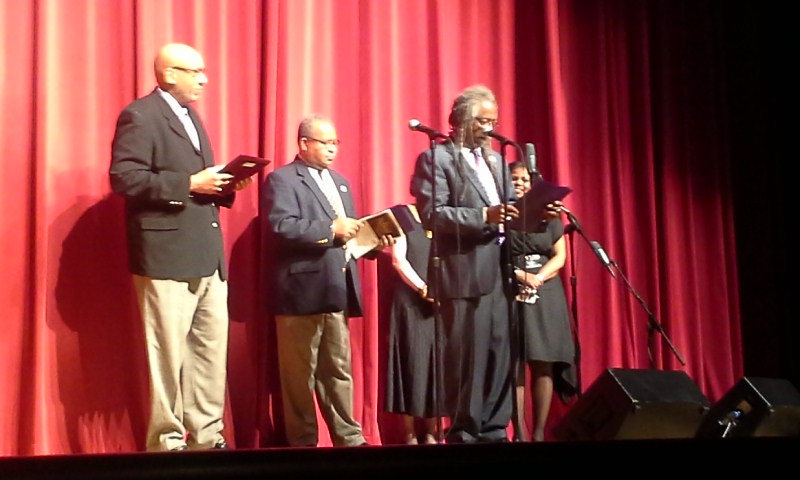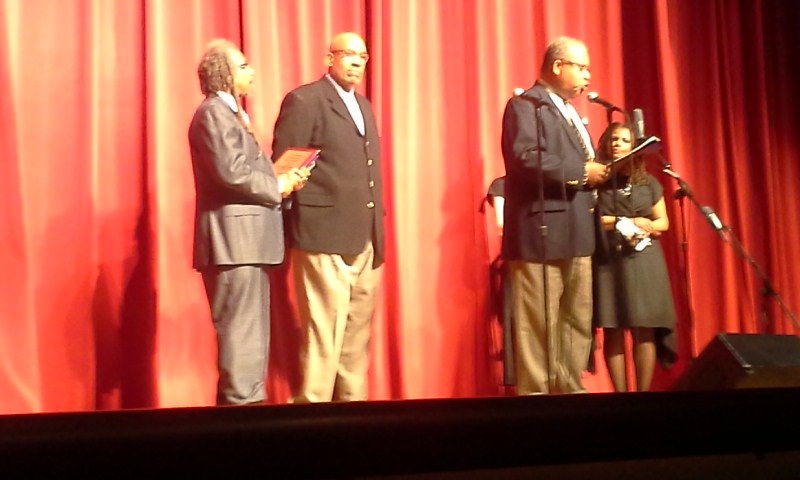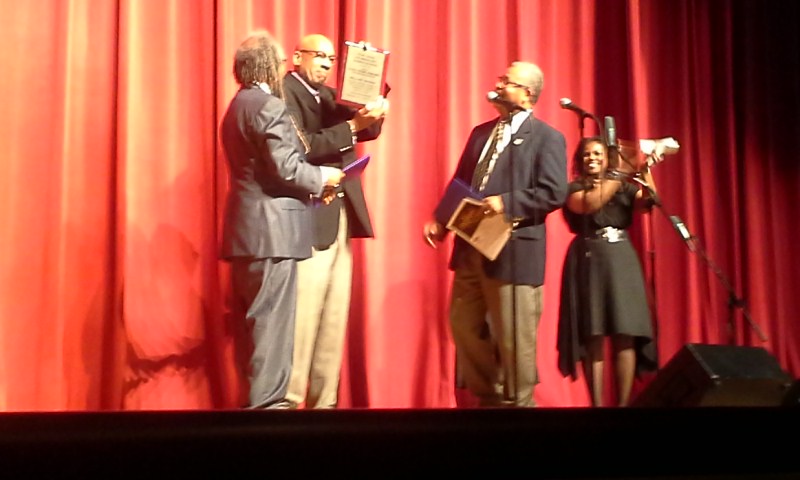No hidden agendas here; taking particular interest and pride in younger African Americans who are working in jazz in entrepreneurial pursuits, last January at the NEA Jazz Masters awards program at Dizzy’s, at the pre-show media event, I met Brian Pace. His principle entry point in the jazz community has been in the visual media marketplace, particularly his video interview series, The Pace Report. What was also of interest was his news reporter (as opposed to “glorified fan”) approach to the task of interviewing artists; no surprise given his considerable legit news experience, detailed below. You can sample the Pace Report and some of his various interviews at thepacereport.blogspot.com and www.thepacereport.com. Clearly some questions for Brian Pace were in order…

Brian left, with (unidentified), the brains behind Jazzcorner Lois Gilbert, and JJA Prez Howard Mandel
What’s your background in music media and how did you get started down this path?
I’m originally from Indianapolis, Indiana. I got started in television production in high school at WJEL-FM/TV at North Central High School. They offered a class where they taught teens how to produce, write, and direct their own shows which aired on the local public access channel. They also had a student run radio station and we had to produce radio spots and DJ live shows and all the sporting events. It had a low signal, but teens played the music they wanted to for their shifts. This was also the time I joined the Youth Telecommunications Workshop for Indiana Black Expo. This program was created to teach African-American teens between the ages of 13-17 television production skills in which they produced local programming geared towards teens but as a need to get more students of color behind the scenes in television and film. It was also this program that got me to make a guest co-host of Black Entertainment Television’s “Rap City” with host and now comedian Chris Thomas. Upon graduation I was a producer and director for Indiana Black Expo’s video and public relations department working with international clients like Coca Cola and McDonalds.
I attended the University of Arkansas Pine Bluff where I got a job as the weekend disc jockey at KPBQ and KZPY-FM. It was there I got wonderful on-air experience doing country music and urban soul for Pine Bluff Radio, INC which owned three stations. One of my dear friends got me a radio producing job at WMC-AM in Memphis, Tennessee. I ended up transferring to The University of Memphis where I was working at the number # 1 news/talk, television, and FM station in the city. While there, I produced news segments and co-anchored the “Sunrise” with the late Dave Black who was the agriculture news director for WMC news. I was also blessed to intern on the television side at WMC-TV while working at WMC-AM and studying in college at the same time. During my time in school I worked as a producer for WHBQ-AM, and DJ and producer at WPLX-AM. When I finished school I moved to Detroit where I took many jobs in broadcasting like reporter/producer at WXYT-AM, Executive Producer and Reporter for the I.E. American Radio Network, Writer and Production Assistant at WXYZ-TV, and Marketing and Promotions at WCSX-FM. I was also the stateside reporter for Mississippi Public Radio for one year. Later I produced freelance work for WBGO Journal for WBGO-FM in Newark, New Jersey.
How did jazz come on your radar screen and what’s been your experience with the music in your media pursuits?
Jazz music was always played at my Grandparents home in Detroit, Michigan. In fact, all forms of popular Black roots music was played there. Blues, Rhythm and Blues, Soul, and Jazz was where my deep love of the culture came from. My grandfather was a barber, math and carpenter teacher at Mumford High School, and was also a private contractor. My grandmother was a labor organizer for one of the major unions in Detroit. My grandfather was jack of all trades and used to cut Kenny Burrell and Elvin Jones‘ hair in the 1950’s. My granddad built this beautiful bar in the basement of their home in northwest Detroit and that was a staple where many of their friends would come over and stay all night playing cards and dominoes. In the basement “Paw Paw”(that’s what I call my grandfather) and “Granny” used to play those gothic Jimmy Smith and Jimmy McGriff records. I think this was also how I’ve been able to shoot film and work late night into the morning working with artists today due to my grandparents all night shindigs!
My real first exposure to the music was when he’d try to teach me to play checkers and he played one of his favorite pianists, Dave Brubeck. “Jazz Goes To College” was my real foray into jazz music at 7 years old. I can see why now, looking back some 30 years. My granddad was an educator and an intellectual. Brubeck was the music of my grandparents generation long before rock and roll came along. But, Paw Paw was also an avid Louis Jordan and Charles Brown fan as well. The real record that my granddad played me that moved me was Duke Ellington‘s “Live at Newport”. Man, he had three copies of that record. Every year my granddad bought me jazz recordings and would teach me what big bands had the best players as well as the history of the music.
In addition to my hangs with Paw Paw, one of my favorite hangs was going to the famous Bakers Keyboard Lounge on Livernois which was under 10 minutes from their house. I used to see live jazz music at an early age and loved it just as much as hip-hop, which is the music of my generation. One more VERY important part of my love for the music and culture was Mr. Eugene Potts in Detroit. I used to hang at the barber shop with my granddad on the east side of Detroit. The shop was located on the corner of Chene and Mack. Right around corner was Potts Record Shop. Mr. Potts in addition to running his record store, was also a choir director and arranger. Mr. Potts taught me about Thomas A. Dorsey and some of the elements of the Blues, Jazz, and Gospel music. He’d give me stacks of records that were monumental in my learning of the music and history of Black music. At age 12 he gave me Stanley Jordan‘s debut album, and to this very day I am still his biggest fan. Mr. Potts gave me Roland Kirk, Pat Metheny, Stan Getz, Jean Luc Ponty, Bob James, David Sanborn, David “Fathead” Newman and endless records in my early teens. By the time I was 16, my musical tastes were so advanced due in part to my granddad and Mr. Potts.
Talk about some of your more successful encounters with jazz artists in your work.
I think every encounter with the artists I shoot for The Pace Report is successful. One, the artists or group gets treated equally. Two, The Pace Report was needed in that I needed to build and maintain a relationship with the record labels, publicists, management, artists, club venues, and music fans so that they can all interact via the internet and social networking platforms. The internet is what radio used to be! For the people, by the people! And The Pace Report has done great job getting the fans in touch with their favorite artists and the artists want to communicate with their fans. I still have some goals to accomplish but I haven’t lost sight nor God’s vision for me to fulfill his will.

With Branford Marsalis at the 2013 NEA Jazz Masters event at Dizzy’s
Your credo says the Pace Report is about “Presenting the Truth in Media”. Speak to that emphasis on the “Truth” as it pertains to your various observations of the music media.
There have been times where I’ve interviewed artists where the source of info was incorrect! Some of these sources are from credible and famous books and magazines, only to find out some or most of the information was inflated or not accurate at all. For years as a journalist readers and viewers have placed certain reporters or publications on a pedestal and hold them as “the law.” Now, with the over-saturation of bloggers and news websites, with slanted political views or favoring a certain position, then you’re misleading the people with false info. Plus, today’s news has gone in the way of the tabloid “crack” mode, meaning, “If it bleeds it leads, but lets make money by any means!” And some of the news organizations have made money by not checking the facts and its just business as usual.
I’m “Presenting the Truth in Media” because I’m going to the direct source! The artist will tell their side of their history not some journalist’s inflated version of their interpretation just to gain views or to sell copies. Every artist or group I’ve interviewed and profiled have been candid as well as frank about what makes them do and create what they do. In presenting their truths, its up to me to let them speak and bring everything to light that needs to cleared and open and let the viewers decide and learn from my dialogue with them.
How did jazz journalism and your media efforts intersect and develop?
I began The Pace Report based on three major influences of media that I saw as a teenager. On Sunday nights, Dr. Ben Sidran hosted and performed a groundbreaking show on VH-1 called “New Visions”. The show was my foray into the live jazz performances and interviews with the legends and newcomers to the world of jazz and blues. I saw the Marsalis Brothers, Courtney Pine, Dr. John, Jon Hendricks, Terri Lyn Carrington, The Microscopic Octet and endless others play and share their ideas about their music and works. Then, pianist Ramsey Lewis hosted a show on Black Entertainment Television that did the same thing as Dr. Sidran, but it wasn’t like “New Visions.” Then, Dr. Billy Taylor used to host the jazz segments on CBS’s “Sunday Morning” and he, like Dr. Sidran, became my heros! These guys really got me schooled on the art of our culture and got me to start reading biographies and studying the legends.
Now lets fast forward to 2003. Ramsey Lewis hosts the nationally syndicated PBS show “Legends of Jazz”. Mr. Lewis interviewed the legends and I began to see the lack of a couple of things. One, the focus of showcasing the culture was being weeded out to reality TV programming like “American Idol” and “The Real World.” Two, people of color are not carrying on the legacy of Dr. Taylor and other respected broadcasters like Gil Noble, Ed Love, Carl T. Rowan, and Tavis Smiley. So when I took my rich television and radio skills that I learned over the years and fused it with the social networking media that we’re in, I created a personal and up-front multi-media format that viewers and readers can pull up on their tablets, smart-phones, and internet driven devices.
What brought you to your current Harlem home-base?
Harlem is where one of the most important cultural experiences took place. The Harlem Renaissance was where the literary, music, fashion, religions, and language took shape that changed the Black experience forever. The new Harlem still reflects some of the old 1920’s. I wanted to come back to the roots of the experience and I think the spirits of old have had a strong presence in my work and attitude as well. I live a half block from the old Savoy Ballroom. That corner still speaks volumes without saying a word.
Given your observations of jazz and the jazz community, what’s your overall sense of the music here in the year 2013?
I believe jazz, like hip-hop, still is evolving and moving forward. I just posted my interview with pianist Christian Sands. This brotha is “outta this world”! He’s the last descendant of the late Dr. Billy Taylor, yet be brings a different flavor to the music and game. So do other pianists like Eldar, Orrin Evans, Marc Cary, John Medeski, and Gerald Clayton.
What I’m tired of is, the jazz community, especially writers, have gotta stop rehashing the past and riding their own coattails! What I mean by this is simply, BECAUSE YOUR A WRITER THAT’S BEEN ESTABLISHED FOR DECADES, IT DOESN’T GIVE YOU THE RIGHT TO PUT DOWN AND BE HARSH TOWARDS AN ARTIST’S WORK OR BODY OF WORK! I feel so sorry for the veteran writers that continue to bash producer and instrumentalist Robert Glasper. Glasper did what Miles Davis did with fusion jazz in the late 1960’s. Or, jazz writers who don’t want to acknowledge and respect guys like Medeski, Martin and Wood or US 3 or drummer Jamire Williams‘ EMiMAJ project. I love and respect all forms of music and for a writer to diss or disrespect ones work, that’s not a good move.
Many established writers feel that they’re entitled to being the so-called authority on the music and people quote them as the law! They may even have degrees to back their knowledge. But, a lot of times speaking and reading other writers work, they put their views on a high pedestal and have many times left the reader not interested in reading their work again. James Baldwin, and Ralph Ellison wrote about what they knew, the black experience. They wrote critical analysis on music, politics, the arts, and religion. But what sticks out about their work is that they wrote from the heart and touched a nerve with readers. That’s what I’m doing with The Pace Report. I want viewers and readers to be compelled to spend time in a jazz club or music hall from Ramsey Lewis to soul icon Lenny Williams. My point, GET OFF YOUR HIGH HORSE AND WRITE FOR THE PEOPLE!
The major important fact of The Pace Report is that I’ve created community. I wanted as a journalist to let the artist set the record straight, as I stressed earlier. Some writers have forgotten that readers and viewers make the final decision. One or two bad reviews or negative interviews set musicians away from journalists. I’ve been told endlessly from many musicians over the years that they’ve enjoyed speaking with me and that they’ve expressed a disconnect with writers in general. Some have told me that writers can be mean-spirited and cold. Respected writers like you, Greg Thomas, and music websites like irockjazz.com and NextBop.com respect the basics of journalism. The who, what, where, why, when, and how.

With NEA Jazz Master conguero Candido
Speaking of writers like Ellison from yesterday, and today Greg Thomas, what’s your sense of African Americans writing about jazz?
I think the way the media industry is going, people of color have a great way to express what we need to say as a people via the social networking means of communication. Jazz is just another sidebar of what I write about. Now that the American people have elected the first President of Color and he’s invited soul, blues, and jazz musicians to perform at the White House, now is the time to make your voice known!
That’s why The Pace Report has taken off. I’m talking with the movers and shakers of the music world and they’ve been candid about their lives and art. So, as a Black journalist I hope that I’m carrying on Dr. Taylor’s legacy with his CBS segments that he hosted and produced for some 20 years. I hope that my race and political dialogue with the artists opens the door for people to have constructive conversations that both blacks and whites can agree to disagree upon. Me allowing to this helps other young journalists to do what I do via the black experience so other up and coming journalists can do the same, but better.

With Pat Metheny
What have you got on tap for the Pace Report and what are some of your aspirations with the work?
With The Pace Report about to enter it’s 5th anniversary in July, I will be getting more contemporary in the artists I interview. Jazz and soul music will be what my viewers will always expect, but its also time to interview the Paul Simons and Stevie Wonders of the recording industry. It’s beginning to move in that direction with some of the names that I’ll be interviewing soon and later in the year. Also, artists are hiring me to shoot their video and still photos for their upcoming recording projects. I’m glad that I’m working for myself for my production company and at age 40 more and more new doors are opening for me.













